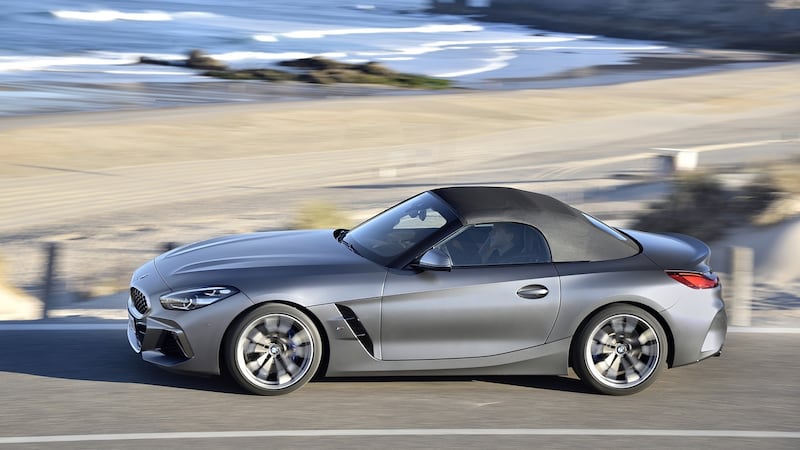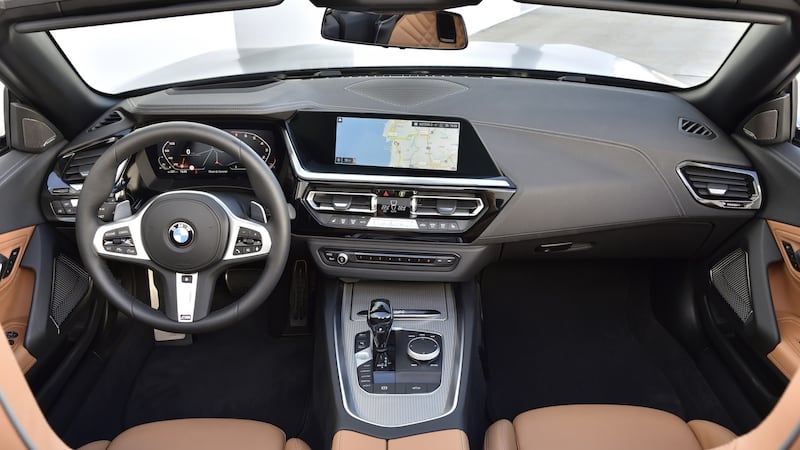Another week, and another new BMW put through its paces on and off the track. Last week we reported on the flagship 8-Series coupe. This week it's something a bit more controversial – at least according to the internet forums.
The online debating hubs have buzzed about its polarising styling, but the Z4 – particularly in its M40i guise – is a quality machine. BMW crows that it’s a Boxster-challenging sports car, but the bland steering is the ceiling that its slick chassis butts against in its lofty ambitions. Other than that, though, it’s comfortable, easy to drive quickly, well equipped and far better than its predecessor.
Ignore the sunshine of the images: our test was in heavy third-click wiper weather, which shouldn’t go hand-in-glove with a car like the BMW Z4 M40i. But “proper sports car” is the BMW claim for the new Z4, and a proper sports car should be able to handle anything.
It’s a claim that’s hard to comprehensively support on a day like today, when the grip is low and inconsistent and aquaplaning is a twice-a-kilometre threat.
But it might be getting towards it (except for its steering), at least in the wet. It’s still short, at 4.3m long, but it’s now squat as well, spreading out across 1,864mm of width.

And it's effectively the same car underneath as the new Toyota Supra.
The 3.0-litre, straight-six turbo is a cracking engine, with 250kW of power and 500Nm of torque (both of which sound like conveniently managed numbers, don’t they?).
BMW claims it’s good for a 4.5-second sprint to 100km/h but I’m here to tell you, that figure is not replicable in the rain, even with standard launch control.
Instead, the place to enjoy the motor in these conditions seems to be letting it lug down deep in the rev range and making the six-pot work through all 500 of the Isaacs that are already stepping on the flywheel at 1,600rpm.
There, in the fat part of the torque curve, lies more than enough gristle for daily life, regardless of which of the eight speeds the Z4 decides to put itself into. Yes, you can decide yourself via a nicely crafted paddle behind the steering wheel, or the gear lever, but that’s it.
There’s no manual option on any of the three engines; BMW says there’s no demand for it, but it’s also a tonne cheaper to engineer a car to swallow just one transmission. So there’s also that.
Setting the Scene
The first Z4 was a great piece of positioning from BMW, with a classic short tail-long bonnet stance, a quality chassis, a sweet in-line 3.0-litre six and rear-drive flair. It just lacked the last few per cent that separated the great from the very good, but found a sweet spot below the Boxster and (well) above the MX-5.
The second one threw that out the window and turned the Z4 into a 6-Series lite, with a folding metal roof that added weight in all the wrong places and messed with the proportions.
And now here comes the third. The can-opener has gone, with BMW reverting to a cloth roof that’s lighter and needs less space to package. But it retains the second generation’s longish bootlid (sculpted in plastic, with a small lip spoiler) just the same, with BMW moving the driver forward to improve the handling.
In reality, it only moved the driver forward because the Z4 sits on the new KLAR modular architecture (that also houses the 5-Series) and that’s where the new layout demanded the driver sat.
The stance seems completely different to either of the first generations, seemingly wedgier rather than squat, and more focused on a muscular rear end than a long nose.
It’s also 85mm longer than the second generation, 74mm wider (with the front track an astonishing 98mm wider and the rear wheels 57mm further apart) and 13mm taller, even though the wheelbase is 26mm shorter (2,470mm) to promote agility.
For such a car, though, it’s not light. At 1,535kg, it’s almost a neat 1.5 tonnes, though the lesser sDrive20i 2.0-litre version is 1,405kg.
The multi-layer soft top saves more than 50kg over the metal version, stretching back further to create a coupe-like profile when it’s fitted. It can also be raised or lowered in 10 seconds at up to 50km/h.
There are good points to go along with that, including the arrival of a significant storage area behind the two seats that will swallow most sports bags or overnighters, and the easy adoption of all of the 5-Series driver-assistance and infotainment tech.
It's not just that it handles, but that it handles comfortably, without stress
BMW wanted the Z4 to stand out and play by a different interpretation of its own design rules. It sure does. The goal was to take the Z4 and add some Z8 design to it, because the engineers forced the driver so far forward that the old proportions couldn’t be replicated.
Its designer, 31-year-old Sydney penman Calvin Luk, loves the Z4 lineage, and his original Z4 3.0-litre takes him to and from BMW HQ in Munich every day.
“The Z8 proportions, you can see with the lights high up on the kidney grilles. Further down, we have the lowest kidney within BMW to ground it,” Luk explained. “There is also just enough of the shark-nose lean in the front and the bonnet is really low so it’s attacking the road.
“The wedge makes it very different to the previous two generations. This wedge really pronounces the pouncing feel.”
That Handling Question
Does the Z4 handle? Yes, mostly. Yes, it does.
It’s not just that it handles, but that it handles comfortably, without stress and with easy access to the speed in the chassis.
Apart from the skid-control interventions at the outer edges of the Z4’s grip levels (which can be turned off), the keys to the Z4 are also just about all you need to unlock every scrap of potential in the KLAR-based chassis.
It’s really that easy to drive it quickly, even in the wet.
The basis of this is a front-engined layout with rear-drive, and that’s a good start for anything with go-fun promises. There is a five-link independent rear end (so, the most technically advanced kind) and a double-joint strut front end with electro-mechanical steering. BMW claims it retains a 50:50 front-to-rear weight distribution.
And yet . . . That steering holds back what teases to be a wonderful package. In the conditions we had, it was unnaturally bland and slow to self-centre on the way out of corners in its standard mode.
It worked well enough, but lacked the inspiration and the confidence in its accuracy to take you deep into the potential of the car.

The steering shifts it up in the Sports modes, with the extra weighting and greater precision lifting the driver’s spirits, but it only gives its best feedback right at the outer edges of the car’s grip.
It’s a frustrating glimpse into what might have been, and BMW would be onto a mighty machine indeed if that outer-edge level of nibbling and nuanced road feel could be brought to bear throughout the car’s handling range.
The engine-transmission combination is a cracker, though, especially when it’s mated with the tricky M-developed Sports active limited-slip differential.
The M40i’s engine starts out all gruff and muscular, as though it’s been at the gym to try to hide an inherently sweet personality, but you still know it’s there.
The water-cooled turbo huffs hard from very low in the rev range, and it’s so effective that its torque peak arrives at only 1,500rpm. Couple that to a power peak that holds on until 6,500rpm and you’ve got a full 5,000 revs of more or less maximum performance.
Or, in other words, there are only about 800 revs in its range when it’s not giving either its maximum torque or its maximum power – and the rise up from idle.
It’s a wondrous thing, silken to its core, utterly smooth and so hushed by the turbocharger that its noise has to be embiggened to give it the sound to match the urge.
The interior is a step into a new direction for the Z4, and it's largely good news
Stand on the throttle at any speed, in any gear, and the Z4 leaps and hammers, threatening the grip of the rear wheels until the diff gets a chance to turn the urge into bite. There’s no point where the engine feels even just “good”, much less ordinary, and it’s only ever a flicked toe away from piling on speed.
The transmission, too, is fabulous. Plenty of carmakers source their eight-speed automatics from ZF, but only BMW’s versions snap and crack through the shifts with enough positivity to make you overlook the manual’s absence.
The thing about it, too, is that the powertrain combination makes it a lovely device at city speeds, too, easing through heavy traffic with abundant torque, a rich exhaust note and rapid downshifts when you need them, then adds easy cruising when you don’t.
Living with it
The interior is a step into a new direction for the Z4, and it’s largely good news.
There’s more space inside, for starters, and the luggage space has gone to 281 litres, which is OK for a cabrio and 50 per cent more than the old one had, especially when there’s enough space behind the seats for a set of golf clubs or a couple of sports bags.
There’s a two-zone climate control system (optional on the cheaper versions), which seems a bit pointless given the inherent selfishness in two-seat cabrios anyway, ambient lighting and a 12-speaker, 464-Watt Harman Kardon audio system.
It all comes together mostly well, though there is a lot of design busy-ness around the A-pillars, with speakers, vents, switches, mirrors and all converging in a small area.
The new digital instrument cluster works well here, though the reverse tacho, spinning anti-clockwise, will take some getting used to for anybody who doesn’t already own an Aston Martin.
The pity of it is that BMW couldn't pull the two 10.25-inch digital screens together in the way Mercedes-Benz has done so successfully. Instead, the instrument cluster version sits beneath its own shroud, while frustratingly large areas of useless blackened glass flank the live parts of the infotainment screen. And the two don't line up.

BMW calls the operating system its “7.0” setup, which can be personalised to suit what each driver wants to have, with up to 10 pages for swiping and up to four tiles of content per page.
It’s a far more practical place to spend time than either of its predecessors, with another 23mm added to the seat rails so taller people have a bit more space. There are cupholders beneath the centre armrest and there’s even a large portal in the rear bulkhead so longer pieces can slide from the boot to the cabin.
The seats are a treat, though, and hold fast and easily, while being comfortable for long hauls as well.
Perhaps the most frustrating part of the layout, and the one which shows why BMW attacked the “sports car” thing with only one hand, is that the gear indicator is tiny, sitting down low in the instrument cluster right next the external temperature gauge, and it’s also the same size and colour.
And so . . .
BMW will probably sell quite a few of these, and it deserves to because it’s mostly a very good car. Hopefully, some tuner out there can boil down the essence of the steering so that its good stuff sticks around for the whole handling envelope and not just the part you lick. And hopefully someone can modify one so it looks like the concept car.
And other than that, there’s not much you’d really need to improve.











